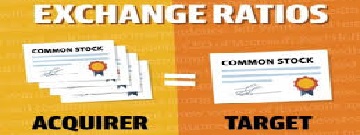Stock Based Merger Arbitrage Spreads
Is it possible that when calculating stock based merger arbitrage spreads the deal spread in the offer can trade at a premium? A value ABOVE the offer price as calculated from the acquirer stock price?
A premium is where the target stock trades above the offer price. This suggests the arbitrageur will lose money being long the spread if it closes according to the existing agreement. The most frequent cause for a spread premium is the anticipation of a higher offer. However, this is not always the case. This article analyses in depth and explains how and why this spread premium is possible. We also give an example how the arbitrageur can profit from similar situations.
On the morning of the 24th September Barrick Gold (ABX) announced a merger with its rival Randgold (GOLD) in an all share deal (You can find a list of the current largest US cash only spreads here). The terms of the deal will give 6.128 shares of ABX for each share of GOLD. The deal is expected to be completed in the first quarter of 2019. The market reacted favourably to the deal and both stocks traded higher pre-open.
Calculating Stock Based Merger Arbitrage Spreads
So what’s happening here? Convention dictates following the deal announcement the target stock trades sharply higher (so far so good) leaving a small gap before closing on the offer price. This gap is the spread and represents the uncertainty surrounding the completion of the deal. This uncertainty is generally deal specific and can range enormously but is most likely to be around the 2-3% mark.
For a few days following the announcement, GOLD consistently traded above the equivalent offer price. Thus leaving no opportunity for merger arbitrageurs to make a profit using a conventional buy and hold (until deal completion) strategy. We shall investigate this scenario further.
As mentioned above, the most frequent cause for a spread premium is the anticipation of a higher offer. This could be a rival bid or an increased offer from the original acquirer to overcome any management or shareholder resistance. By reading the first pages of the press release, we can reasonably eliminate the latter. Both management teams are fully on board with the deal and see a number of positives for the combined entity. Synergistic cost savings of the two firms appears to be far greater than could be achieved by combining with a rival suitor.
Shareholders always welcome a higher offer, especially a bidding war. However they will also generally be content to benefit from the unexpected and initial increase in their stock value. The possibility of a rival bid in light of the aforementioned reactions and synergistic expectations seems unlikely. Rival bidders would have to pay an increased premium above what has already been offered. They could also potentially find themselves in a bidding war with an extremely determined opponent. In addition, there is an agreed payment of a (relatively) small termination fee ($300m) should the deal fail.
A Practical Example
Here is the math (you can also click here for a free downloadable comprehensive example spreadsheet for making your own calculations).
ABX = $11.20, GOLD = $69.90
OFFER VALUE = $11.20 * 6.128 = $68.63
SPREAD = OFFER VALUE – GOLD = ($1.27)
The value of the spread is negative $1.27 as the current stock price is trading higher than the offer value (some markets observers may reverse this terminology). Therefore, an arbitrageur executing the traditional strategy would purchase 100 GOLD and short 100 * 6.128 ABX. The expected profit (loss) in this instance would be ($1.27) * 100 = ($127).
Why Would a Trader Buy this Spread?
The deal documents clearly state Randgold is committed to paying the expected $2.00 dividend. This is likely to be paid at roughly the same time as the deal is closed. Barrick will also pay 2 dividends totaling $0.08 ($0.03 and $0.05) before the expected date of deal completion. Once we add in the effect of dividends things begin to make sense.
The GOLD dividend will provide additional income of $200 (100 * $2). However, there will also be a capital payment in lieu of a dividend for the short stock position. This is because the act of short selling has created two long stockholders. The original holder, who lends you the stock AND the new holder who bought the stock that you sold short. The dividend paying company will pay the original holder. You, the short seller, will make a capital payment in lieu of a dividend to the new additional holder. This ensures there is no free lunch. Your offsetting gain to this payment is the ex-dividend price decline of your short stock position. In this example the total of the two dividend payments will be (612.80 * $0.03 + 612.80 * $0.05) = $49 (rounded).
The Trade
In our example, buying the target and shorting the acquirer in the correct ratio costs an initial debit of ($127). That is, you initially pay out more than you receive from the short sale proceeds. The receipt of the target dividend, $200 and the payment in lieu of acquirer dividends ($49) leaves the strategy with a net gain of $24 instead of a loss of $127. This is how the arbitrageur is able to make a profit in light of a negative spread.
Recall the “no free lunch statement” above? You may be wondering why not just wait until Barrick goes ex-dividend and then short the stock? In this case, the value of the spread is calculated using the new ex-dividend price and be will lower
$11.17 * 6.128 – $69.90 = ($1.45).
Nevertheless, the dividend adjustments will only be made for the remaining $0.05 dividend. The final figure will work out the same. By not hedging with the acquirer stock (shorting), arbitrageurs expose themselves to spread risk and market risk and may end up with a large loss. This exposure would be considered outside of the realm of standard merger arbitrage. See here for a comprehensive definition of this topic.
Conclusion
We have shown how to profit from calculating stock based merger arbitrage spreads that initially look like losing trades. Dividends are an important aspect of corporate finance especially for larger companies. Subsequently, it is important that they are always included in the profitability calculations. Therefore, we advise the aspiring arbitrageur to read carefully ALL offer documents for relevant data before making any investment decisions.
These figures do not take into account any tax implications, rates for which will differ for dividends and capital distributions in lieu of dividends Also, we have not taken into account the commission costs although these can be as low as $0.005 per share using online services such as Interactive Brokers. (Yes, that’s 200 shares for a buck!). Nevertheless, we think that’s probably enough for now (we’ve deliberately omitted time value of money and ABX payment timings in lieu of simplicity).
Finding this information useful? Here's what you can do to help...
- Share this page using the toolbar links at the left of your screen or at the bottom for mobile users on your preferred social network
- Sina Weibo
- Twitter etc.
- Follow us on twitter @MergeArbLimited.
- Become friends with us on Facebook
- Register for news alerts and merger arbitrage deal analysis postings via email using the sign up form.
- In addition to these, an RSS feed is also available at the bottom right of the page.
- Contact us using the details given on the Contact Us page.
- Donate using the paypal widget in the sidebar. It’s gladly appreciated and we need the coffee! See the Paypal section for additional incentives
- Share this page using the toolbar links at the left of your screen or at the bottom for mobile users on your preferred social network
Thanks for reading!




